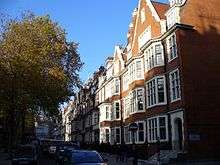Hornton Street

Hornton Street is a street in Kensington, London W8. It runs north to south from Sheffield Terrace to Kensington High Street.
History
Some of the road, at least, was originally called Campden House Road.[1]
A chapel on the corner of Hornton Street and Hornton Place was built in 1794 for Congregationalists on land owned by William Phillimore.[2] By 1858, it became a Baptist chapel.[2] However, it was demolished in 1927.[2]
The street was home to a Nonconformist school until it was torn down in 1868 for the construction of the Metropolitan Railway.[3]
The musician Sir Charles Stanford (1852-1924) lived at no 56 from 1894 to 1916, and this is commemorated with a blue plaque, erected in 1961.[4]
Many of the houses are listed, including the entire terrace from 12 to 54, built form 1903, and designed by Frank Chesterton; running between Holland Street and Hornton Place, opposite Kensington Town Hall and Kensington Central Library.[5]
References
- ↑ "The Pitt estate | British History Online". British-history.ac.uk. Retrieved 2016-10-01.
- 1 2 3 Denny, Barbara; Starren, Carolyn (1998). Kensington Past. London, U.K.: Historical Publications. p. 127. ISBN 9780948667503. OCLC 42308455.
- ↑ Denny, Barbara; Starren, Carolyn (1998). Kensington Past. London, U.K.: Historical Publications. p. 132. ISBN 9780948667503. OCLC 42308455.
- ↑ "STANFORD, Sir Charles (1852-1924)". English Heritage. Retrieved 2016-10-01.
- ↑ Historic England. "12-54 Hornton Street W8 (1191596)". National Heritage List for England. Retrieved 29 September 2016.
External links
![]() Media related to Hornton Street at Wikimedia Commons
Media related to Hornton Street at Wikimedia Commons